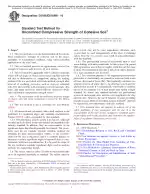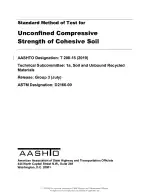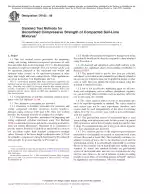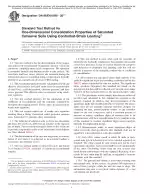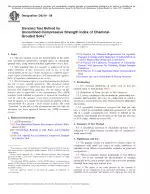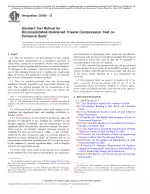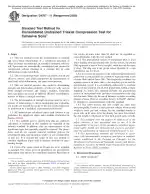ASTM D2166/D2166M-16 PDF Download
Standard ENStandard Test Method for Unconfined Compressive Strength of Cohesive Soil
Also Known As:
The ASTM D2166/D2166M-16 standard is titled "Standard Test Method for Unconfined Compressive Strength of Cohesive Soil." The primary purpose of this test method is to quickly determine the compressive strength of cohesive soils that have sufficient cohesion to be tested in an unconfined state.
The standard specifies that certain types of soils, such as slickensided or fissured structure, loess, very soft clays, dry and crumbly soils, varved materials, and those containing significant portions of silt or sand, may exhibit higher shear strengths when tested using a different test method (ASTM D2850). It also mentions that unsaturated soils may show different shear strengths when tested using ASTM D2850.
Additionally, the standard notes that the sensitivity of the material can be determined by performing tests on the same sample in both its intact and remolded states, but this method is only suitable for soils that can retain a stable specimen shape in the remolded state. For soils that cannot retain a stable shape, an alternative test method such as a vane shear test or ASTM D2850 can be used to determine sensitivity.
The standard emphasizes that the quality of the test results depends on the competence of the personnel performing the test, as well as the suitability of the equipment and facilities used. It cautions that compliance with the relevant practice (ASTM D3740) does not guarantee reliable results, as many factors affect the reliability of test results.
In terms of the test method itself, it covers the determination of the unconfined compressive strength of cohesive soil in the intact, remolded, or reconstituted condition, using strain-controlled application of axial load. The test method provides an approximate value of the strength of cohesive soils in terms of total stresses. It is applicable only to cohesive materials that will not expel or bleed water during the loading portion of the test and that will retain intrinsic strength after removal of confining pressures. It explicitly states that dry and crumbly soils, fissured or varved materials, silts, peats, and sands cannot be tested using this method to obtain valid unconfined compression strength values.
The standard also mentions that it is not a substitute for ASTM D2850, which covers the determination of the unconsolidated, undrained strength of cohesive soils with lateral confinement.
Finally, the standard provides guidelines for significant digits and rounding of observed and calculated values, following the established practice (ASTM D6026). It clarifies that these guidelines should generally be followed, but acknowledges that considerations such as material variation, purpose of obtaining the data, special purpose studies, and user's objectives may require adjustment of significant digits. It states that the significant digits used in engineering design analysis methods are beyond the scope of the test method.
In terms of units, the standard uses the gravitational system of inch-pound units when dealing with inch-pound units. The pound (lbf) represents a unit of force (weight), while the unit for mass is slugs. The standard notes that the rationalized slug unit is not given, unless dynamic calculations involving force and acceleration are involved. It also mentions that it is common practice in the engineering/construction profession to use pounds to represent both mass (lbm) and force (lbf). However, it states that it's scientifically undesirable to combine two separate systems of units within a single standard, so it focuses on the gravitational system of inch-pound units and does not use/present the slug unit for mass. However, the use of balances or scales recording pounds of mass (lbm) or density in lbm/ft³ is not considered nonconformance with the standard.
| ICS Codes | 93.020 - Earthworks. Excavations. Foundation construction. Underground works |
| Language(s) | English |
| File Size | 153.6 KB |

